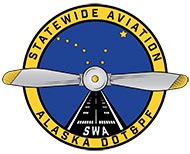Flying in Alaska
Special Considerations
Alaska is a very complex aviation environment. Flying safely here requires thorough planning and special attention. When well planned, flying in Alaska presents no particular problems and can be very inspiring. Alaska summer flying weather is generally good with long daylight hours. But expect delays due to adverse weather and marginal VFR conditions. Do not push the weather. Weather reporting points are far apart. Ask for and give pilot reports often. Though VFR flight plans are not required, they are strongly recommended. Much of Alaska is mountainous. The correct entrance to mountain passes can be deceptive. Dead-end box canyons are common. Airports are separated by great distances so fuel planning must be accurate and alternative routes/airports seriously considered. Magnetic variation may be as much as 25 degrees east. Be vigilant in tracking your flight across the ground. Icing conditions are encountered year round. Most of Alaska's runways are gravel. Many are not lighted. Airspace around major population centers can be quite crowded and contain special restrictions and requirements.
Alaska Statute 02.35.110i Emergency Rations & Equipment requires that an airman may not make a flight inside the state with an aircraft unless emergency equipment is carried as follows:
- The minimum equipment during the summers months is: food for each occupant for one week; one axe or hatchet; one first aid kit; an assortment of fishing tackle such as hooks, flies, and sinkers; one knife; fire starter; one mosquito headnet for each occupant; and two signaling devices such as colored smoke bombs, pistol shells, etc. sealed in metal containers.
- In addition to the above, the following must be carried as minimum equipment from October 15 to April 1 of each year: one pair of snowshoes; one sleeping bag; one wool blanket for each occupant over four.
Several publications are available which contain descriptive information about Alaska's airports, seaplane bases, and aircraft landing areas. Publications that you may be interested in obtaining are the Alaska Supplement from the NACO Chart Sales Office; and Aviation USA from the Aircraft Owner's and Pilot's Association (AOPA).
On the Net, see Guide to Bush Flying by F.E. Potts (http://www.fepco.com/Bush_Flying.html): This book describes bush flying based on the author's experience in Alaska. This web site is virtually the entire book, chapter by chapter.
An Air Travel Note About Flying into Canada
FAA has an informative webpage regarding Flying to Alaska with many helpful links.
While Canadian Aeronautical Regulations apply to aircraft transiting Canadian airspace, Canada accomodates aircraft markings approved for use "in the case of an aircraft registered in a foreign state, in accordance with the laws of that foreign state." Source: Canadian Aeronautical Regulations 202.01 (1)(b)
FAA's Flying in Alaska webpage
Flying in Alaska is an adventure! But it will take some homework. We have teamed up with FAA Flight Safety Office (FAAST Team) in Alaska to provide this information as an aid in helping you plan your trip to Alaska.
Flying in Military Airspace
The Air Force would like the general aviation community to be aware of increased flying and military operating areas during Red Flag-Alaska, Northern Edge, and other major flying exercises. Pamphlets and useful military airspace information is available on this website: www.jber.jb.mil/Info/Alaskan-Airspace-Info/
Transporting Alcohol in Alaska
Many communities in Alaska have banned the importation, sale, and/or possession of alcohol within their boundaries. Pilots flying within Alaska are well advised to determine whether their destination is one which does not allow alcohol. Some local governments require that all persons arriving at the airport submit to a personal search before being allowed to enter the village. Pilots need to be aware that landing with alcohol aboard in villages which prohibit alcohol may result in confiscation of their aircraft. Pilots who are unfamiliar with the alcohol regulations of communities that they intend to visit should go to the Alcohol Beverage Control Board website for specific community information, or telephone the ABC Board office at (907) 269-0350 for more information.

